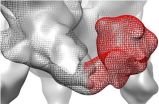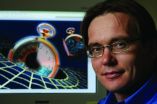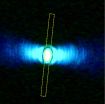(Press-News.org) UC Davis researchers are getting a new look at the workings of HIV and other viruses thanks to new techniques in electron microscopy developed on campus.
The envelope (or Env) protein of HIV is a key target for vaccine makers: it is a key component in RV144, an experimental vaccine that is so far the only candidate to show promise in clinical trials. Also called gp120, the Env protein associates with another protein called gp41 and three gp120/gp41 units associate to form the final trimeric structure. The gp120 trimer is the machine that allows HIV to enter and attack host cells.
Professor R. Holland Cheng's laboratory at UC Davis has previously shown how the gp120 trimer can change its conformation like an opening flower. The new study, published in Nature Scientific Reports Nov. 14, shows that a variable loop, V2, is located at the bottom of the trimer where it helps to hold gp41 in place -- and not at the top of the structure, as previously thought.
"This challenges the existing dogma concerning the architecture of HIV Env immunogen," Cheng said.
Making a vaccine against HIV has always been difficult, at least partly because the proteins on the surface of the virus change so rapidly. Better understanding the structure of the gp120/Env trimer could help in finding less-variable areas of these proteins, not usually exposed to the immune system, which might be targets for a vaccine.
Understanding viral entry
A second pair of back-to-back papers from Cheng's lab uses new techniques in electron microscopy to probe how some common viruses hijack normal cellular processes to enter cells.
Cheng's lab has pioneered techniques in cryoelectron microscopy. Traditionally electron microscopy has relied on coating or impregnating samples with heavy metal elements. Cryoelectron microscopy uses extremely low temperatures to freeze biological structures in place instead.
By taking multiple images from slightly different angles and reconstructing them with computers, Cheng has been able to produce three-dimensional images of viruses and virus proteins and particularly, virus-infected cells.
However, because of the way electrons are scattered from samples, cryoelectron microscopes can only use a limited range of angles, creating a "missing wedge" in imaging infected cells. In one of the papers recently published in the journal PLOS ONE, Lassi Paavolainen and colleagues present a new statistical technique to reconstruct this missing data with no prior knowledge of the sample.
In the companion paper, Pan Soonsawad and colleagues applied the new technique to study the vesicles, or small bubbles that form inside cells when a picornavirus enters. The picornaviruses are a large group that includes the viruses that cause colds, gut infections, polio, hepatitis A and the recent outbreaks of contagious hand-foot-mouth disease (HFMD) spread in infants and children of younger age in U.S. this summer.
Picornaviruses get into cells by getting themselves dragged into an endosome, or pouched-off bubble from the cell's surface inside the cell. Then they exit the endosome and replicate their genetic material, RNA, in the cytoplasm of the host cells.
The new work shows that the endosomes are lined with host proteins called integrins, which are found in cell membranes. When integrins come close together in a membrane, they send signals into the cell. Viruses take advantage of this behavior, Cheng said. Attaching itself to a cell, the virus gathers integrins towards itself, triggering formation of an endosome.
"This virus collects integrins into a pattern so it can be 'swallowed' by the host cells," Cheng said.
Once inside, the new images show the endosomes breaking up as the viruses release their genetic material into the cell, leading to massive virus replication.
Despite the illness they cause, Cheng finds the viruses have their own charm.
"The virus is beautiful, because it has its own geometry that can be reused and redesigned for the benefit of human being," he said.
Indeed, Cheng's laboratory has patented technology that makes use of self-assembling proteins from the coat of Hepatitis E virus, including using them to deliver drugs or vaccines or to target breast cancer.
INFORMATION:
Coauthors on the Nature Scientific Reports paper were Carlos G. Moscoso, Li Xing, Jinwen Hui, Jeffrey Hu, Mohammad Baikoghli Kalkhoran, Onur M. Yenigun at UC Davis; Yide Sun, Carlo Zambonelli, Susan W. Barnett, and Indresh K. Srivastava at Novartis Vaccines and Diagnostics Inc., Cambridge, Mass.; Loïc Martin, Commissariat à l'énergie atomique et aux énergies alternatives, Gif-sur-Yvette, France; Lassi Paavolainen and Anders Vahlne, Karolinska Institute, Stockholm, Sweden.
The PLOS ONE papers include coauthors from University of Jyvaskyla, Finland; Tampere University of Technology, Tampere, Finland; and Mahidol University, Bangkok, Thailand.
WASHINGTON, Nov. 17, 2014 -- They are seemingly the most popular thing on the Internet, the subject of millions of videos and hundreds of memes: cats. This week Reactions answers some of the biggest kitty questions out there: Why does catnip make most cats go crazy? What does it mean when your cat rubs against your leg? How does kitty litter clump? Check out the nearly purr-fect video here: http://youtu.be/6_C9i-2QGeU.
Subscribe to the series at Reactions YouTube, and follow us on Twitter @ACSreactions to be the first to see our latest videos.
INFORMATION:
The American ...
ABBOTT PARK, Ill., Nov. 17, 2014 - People aged 65 and older, who were being treated for chronic obstructive pulmonary disease (COPD) in the hospital and received nutrition treatment (oral nutrition supplements) had reduced lengths of stay, hospital costs and chances of returning to the hospital within 30-days, according to a study published in CHEST.
Chronic obstructive pulmonary disease (COPD) -- which includes conditions like chronic bronchitis and emphysema -- is a lung disease that compromises breathing. As COPD often occurs among seniors, it is one of the leading ...
Alexandria, Va. -- Hurricane Sandy struck the U.S. East Coast in October 2012, leaving about $65 billion of damage in its wake and raising the question of how to mitigate the damage from future storms. It's a question that arises in the wake of most natural disasters: What steps can society take to protect itself from storms, floods, landslides, earthquakes, tsunamis or volcanic eruptions? But the question itself illustrates the complexity of preparing for natural disasters.
Our first instincts might be to protect ourselves as well as possible, but reality sets in quickly: ...
CORVALLIS, Ore. - Engineers at Oregon State University have identified a method to rapidly prepare frozen red blood cells for transfusions, which may offer an important new way to manage the world's blood supply.
It's already possible to cryopreserve human red blood cells in the presence of 40 percent glycerol, but is rarely done because of the time-consuming process to thaw and remove the glycerol from the blood. This can take an hour or more and makes it logistically difficult to use frozen blood.
However, some initial experiments and computer modeling of a proposed ...
RENO, Nev. - The everyday use of a GPS device might be to find your way around town or even navigate a hiking trail, but for two physicists, the Global Positioning System might be a tool in directly detecting and measuring dark matter, so far an elusive but ubiquitous form of matter responsible for the formation of galaxies.
Andrei Derevianko, of the University of Nevada, Reno, and his colleague Maxim Pospelov, of the University of Victoria and the Perimeter Institute for Theoretical Physics in Canada, have proposed a method for a dark-matter search with GPS satellites ...
LIVERMORE, Calif. - Lawrence Livermore National Laboratory researchers have developed an efficient method to measure residual stress in metal parts produced by powder-bed fusion additive manufacturing.
This 3D printing process produces metal parts layer by layer using a high-energy laser beam to fuse metal powder particles. When each layer is complete, the build platform moves downward by the thickness of one layer, and a new powder layer is spread on the previous layer.
While this process is able to produce quality parts and components, residual stress is a major ...
The race to make computer components smaller and faster and use less power is pushing the limits of the properties of electrons in a material. Photonic systems could eventually replace electronic ones, but the fundamentals of computation, mixing two inputs into a single output, currently require too much space and power when done with light.
Researchers at the University of Pennsylvania have engineered a nanowire system that could pave the way for this ability, combining two light waves to produce a third with a different frequency and using an optical cavity to amplify ...
Rice University scientists have invented a novel cathode that may make cheap, flexible dye-sensitized solar cells practical.
The Rice lab of materials scientist Jun Lou created the new cathode, one of the two electrodes in batteries, from nanotubes that are seamlessly bonded to graphene and replaces the expensive and brittle platinum-based materials often used in earlier versions.
The discovery was reported online in the Royal Society of Chemistry's Journal of Materials Chemistry A.
Dye-sensitized solar cells have been in development since 1988 and have been the subject ...
Scientists using a microbe that occurs naturally in eastern cottonwood trees have boosted the ability of two other plants - willow and lawn grass - to withstand the withering effects of the nasty industrial pollutant phenanthrene and take up 25 to 40 percent more of the pollutant than untreated plants.
The approach could avoid the regulatory hurdles imposed on transgenic plants - plants with genes inserted from or exchanged with other plant or animal species - that have shown promise in phytoremediation, the process of using plants to remove toxins from contaminated sites, ...
More than a decade ago, researchers from Brigham and Women's Hospital (BWH) demonstrated that a high dose statin, which lowered cholesterol further than a regular dose statin, provided better clinical outcomes. But questions remained about whether further reducing cholesterol would be even more effective in reducing cardiovascular-related events.
Now, results of the highly anticipated IMProved Reduction of Outcomes: Vytorin Efficacy International Trial (IMPROVE-IT), co-led by researchers at BWH and Duke Medicine, indicate that adding a second drug, ezetimibe, that blocks ...





